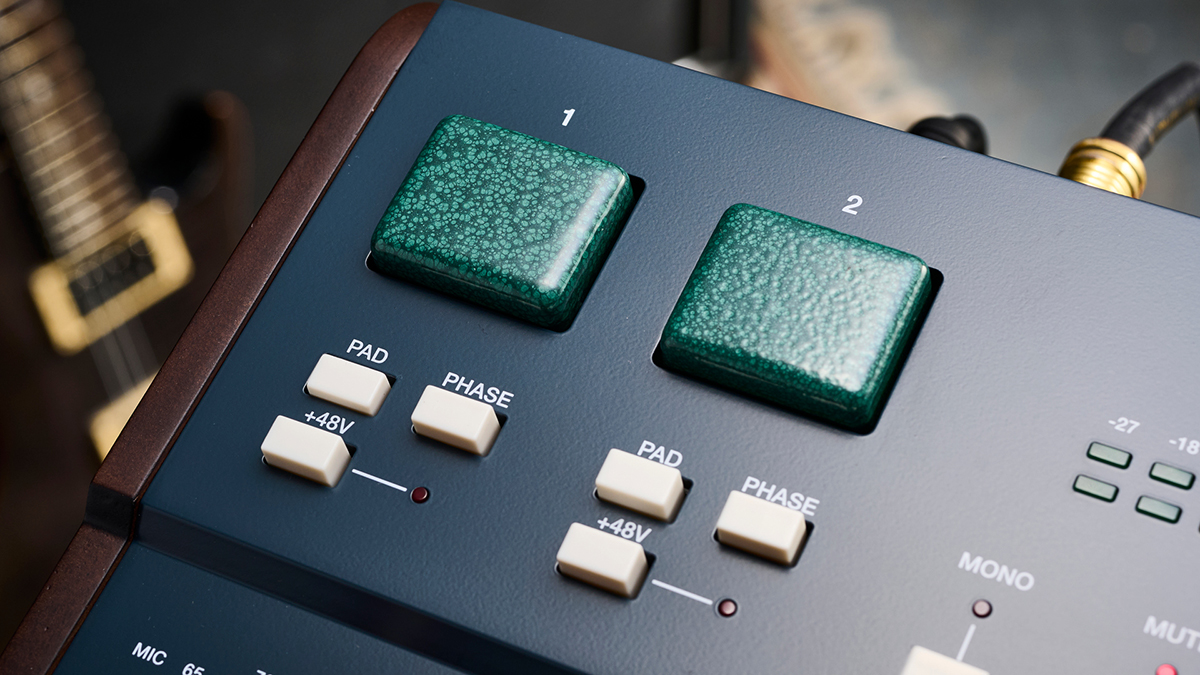MusicRadar Verdict
The i73 Pro 2 won’t appeal to everyone, but if you have a hankering for a traditional transformer coupled preamp integrated into a desktop audio interface, this is a mighty fine solution.
Pros
- +
Classic analogue mic pre design.
- +
JFET instrument input option.
- +
Price includes real-time DSP and native plugins.
Cons
- -
No MIDI breakout cable included.
MusicRadar's got your back
Heritage Audio i73 Pro 2: What is it?
Heritage Audio has a solid reputation for delivering high-performance but affordable retro-inspired analogue hardware. Its latest project couples an analogue preamp with USB-C-based audio interfacing and onboard DSP to deliver three desktop-style interfaces.
It’s the middle-of-the-range i73 Pro 2 that we have for review and this is a 2-in / 4-out 32-bit 192kHz capable device. This features two transformer-coupled 1073 style mic/line input channels with rear-mounted XLR/jack combi connectors. Channel 1 also doubles as a high-impedance JFET instrument input with front-mounted jack.

Outputs comprise a pair of rear-mounted TRS jacks and a front-mounted headphone output. All further connectivity is on the back and includes a mini-DIN connector for MIDI I/O (cable not included), USB-C socket and external PSU input.
Note, that the i73 Pro 2 is USB 2.0 compatible (both USB-A and USB-C cables are included) and it is not USB bus-powered.
The interface is supported by Heritage Audio’s i73 Mixer software (Windows and OS X), which handles minimum latency monitoring, access to the unit’s settings and access to Heritage Audio’s real-time DSP plugins, which you can also record. The recordable DSP plugin aspect will no doubt draw comparisons with other units such as Universal Audio’s Apollo and Apogee’s Symphony.

Heritage Audio i73 Pro 2: Performance and verdict
The i73 Pro 2 top panel is a design of two halves. The left-hand side has traditional knobs and switches for the analogue input stages. Meanwhile the right-hand side houses soft buttons and encoders, including the dual concentric DAW monitor knob for main outputs (centre) and headphones (outer ring).

The mic/line stage includes a 25dB gain range in 5dB steps coupled with a finely notched Output trim (0dB to -infinity). You also get individual Phase invert, plus level Pad and 48V phantom for the mic inputs. Meanwhile, the rather striking dark green squares at the top of the unit aren’t just for show as they are the input transformer casings. Nice touch.
Want all the hottest music and gear news, reviews, deals, features and more, direct to your inbox? Sign up here.

The original 1073 design is renowned for its rich sound and gentle harmonics. The i73 Pro 2 mic input exhibits some very low level odd harmonic distortions but overall is pretty clean. In contrast, the JFET instrument input exhibits a more complex blend of odd and even harmonic distortions. Either way, the i73 Pro 2 is not strikingly coloured.
The i73 Mixer software provides discreet monitor and headphone cue mixes. It also includes two VST3 plugin-capable auxiliary buses for easy addition of cue mix reverb and delay. Heritage Audio has been finessing the software features, and the i73 Pro 2 can now retain its cue mix settings and DSP processing when you close the mixer software, which is good to know. Also, with six channels of USB I/O you can access the loopback routing and target the headphone output directly from your DAW, and simultaneously record both the dry and DSP-effected input signals, which is extremely handy.

The i73 Pro 2 package includes six plugins, all of which are available as AU, AAX and VST3. However, four of these are also DSP capable (channel strip, guitar amp sim, bass amp sim and tape sim). DSP plugins are selected via the i73 Mixer using the four slots for each input channel. All four DSP plugins are very good, and although the amp sims deliver quite specific tones, they are very usable. We understand further plugins are in development, though pricing is yet to be finalised.

Verdict
The i73 Pro 2 delivers an interesting mix of retro flavour, and contemporary functionality, which is a refreshing change from the many neutral and digitally controlled interfaces out there. Meanwhile, recordable DSP plugins and VST3 plugin monitoring are both valuable inclusions. Overall this is a well-conceived unit that should find its user niche.
MusicRadar verdict: The i73 Pro 2 won’t appeal to everyone, but if you have a hankering for a traditional transformer coupled preamp integrated into a desktop audio interface, this is a mighty fine solution.
Heritage Audio i73 Pro 2: The web says
"Working with the i73 Pro is enormously satisfying. The DSP plugins are well chosen to give your rig a flexible front-end, and we love how the preamp gain staging delivers genuine, authentic transformer overdrive."
MusicTech
Heritage Audio i73 Pro 2: Hands-on demos
Heritage Audio
Podcastage
Edward Smith
Harv Video/Audio Stuff

Heritage Audio i73 Pro 2: Specifications
- Inputs: 1 mic/line/instrument, 1 mic/line.
- Input options: 48V phantom, phase, level pad.
- Outputs: 2 TRS jack, 1 headphone.
- Gain range: Up to 70dB of gain.
- Audio Interface: 2-in, 4-out, 32-bit up to 192kHz.
- Mic input dynamic range: 116dB A weighted.
- Line/Instrument dynamic range: 116dB A weighted.
- MIDI I/O: mini DIN connector.
- Interfacing: USB 2.0, USB-C connector.
- Size: 185 x 205 x 92mm.
- Weight: 1.55kg.
- CONTACT: Heritage Audio i73 Pro 2
Jon is a London based platinum award winning mixer, producer, composer and club remixer with a diverse CV that spans dance, pop, rock and music for media. He’s also a long term contributor to MusicRadar's music technology tutorials and reviews. Whether working alone or collaborating he usually handles final mixdowns, so you’ll also find MusicRadar peppered with his handy mixing tips.




